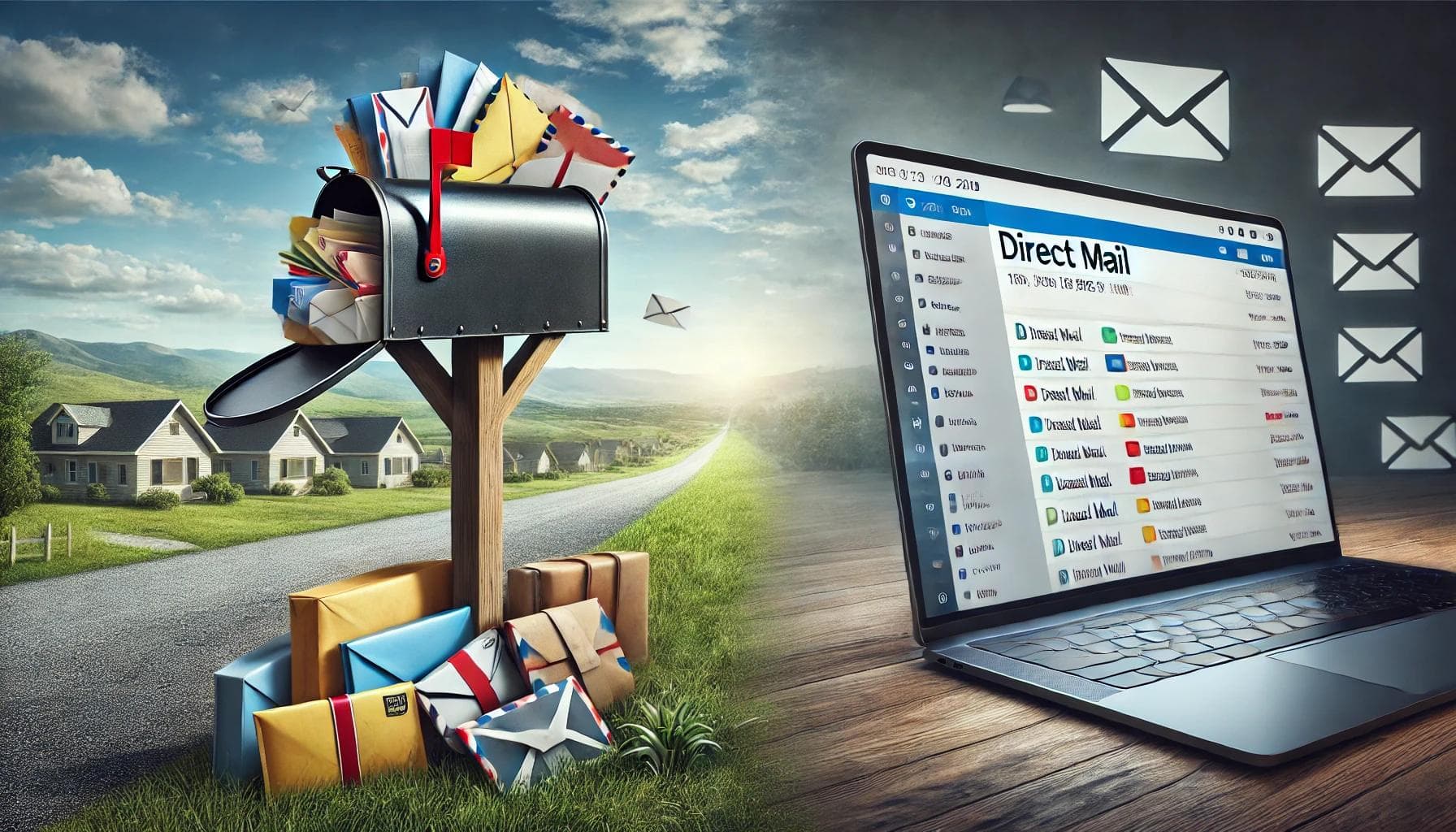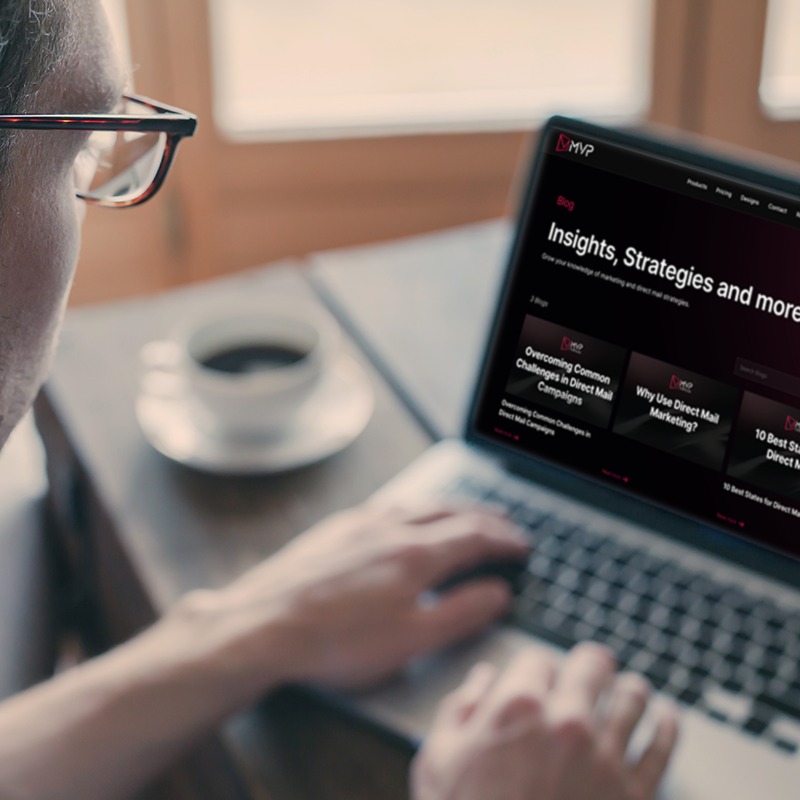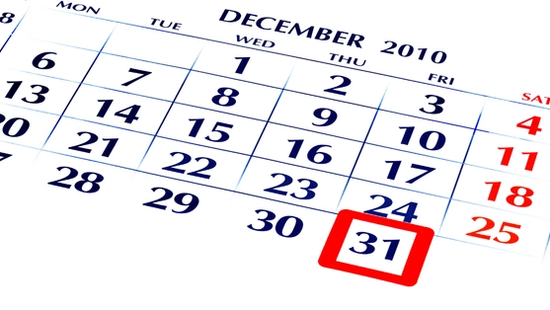Direct Mail Vs. Email Marketing: Which Is Better?
Direct mail vs. email marketing, see which wins for cost, impact, and trust. Learn the pros and cons now and schedule a demo to grow your practice fast.

When it comes to reaching new customers, two strategies consistently spark debate: direct mail vs. email marketing. Both have proven track records, but they function differently and serve unique purposes.
Understanding their strengths, limitations, and how they compare is essential for businesses especially those in competitive fields like dental marketing looking to maximize their return on investment.
Understanding Direct Mail Advertising
What is direct mail advertising? Let’s keep it simple. It’s marketing you can touch. Instead of ads on a screen, it’s postcards, letters, brochures, or catalogs sent right to a mailbox, home or office.
Why does that matter? Digital ads disappear fast. An email gets lost. A social post scrolls away. But direct mail stays. It’s physical. It’s real. You can hold it, pin it, save it, flip through it again. That weight gives it power.
And then there’s the personal side. A name on an envelope. A card that feels made for you. It’s not a pop-up or banner ad screaming for attention. It’s thoughtful. Intentional. That little detail changes how people see it. They notice. They trust it. Sometimes they even feel a spark of nostalgia.
For businesses, this means more eyes, more memory, more impact. Direct mail doesn’t just appear, it lingers.
Want the full picture? Check out our guide on direct mail marketing. Strategy, targeting, tracking, it’s all there.
Understanding Email Marketing
Email marketing is simple. You send messages straight to someone’s inbox. No paper, no printing, no waiting weeks for results. Just quick, direct communication. That’s why it’s one of the most cost-effective strategies in digital marketing. And it’s flexible, brands can push promotions, share news, or nurture relationships with almost zero delay.
Think about it. Unlike print campaigns, which cost money and time, an email can be drafted today and delivered in minutes. If a holiday deal pops up or a market shift happens, you can pivot instantly. That speed matters. And because performance can be tracked, opens, clicks, conversions, you know right away if your efforts are working.
But speed isn’t the only strength. Personalization changes everything. Businesses can slice their lists into groups: by behavior, demographics, or past purchases. Each segment gets messages tailored just for them. Automated flows do the heavy lifting, welcome emails, abandoned cart nudges, post-purchase check-ins. Once set up, they run on their own. The result? Stronger connections, repeat buyers, loyal fans.
Of course, the road isn’t smooth. Inboxes are crowded. Everyone’s fighting for attention. Subject lines have to grab without tricking. Content has to feel valuable, not like spam. Timing is everything, too early or too late, and the message vanishes. Spam filters lurk, ready to flag even legit emails. And yes, open rates are slipping in many industries. Marketers have to test, refine, test again.
So, what’s the secret? Balance. Use automation, but stay human. Personalize, but don’t overcomplicate. Make every message feel relevant. When done right, email marketing still cuts through the noise. It builds trust. It keeps people engaged. And it drives real growth, even in inboxes stuffed to the brim.
Direct Mail vs. Digital Marketing
Direct mail gets called “old school.” Email, social media, and online ads seem to own the spotlight now. But here’s the thing, mail isn’t dead. Not even close. It’s real. It’s physical. It sticks around long after a digital ad fades away.
- Tangibility: A postcard feels different. A brochure feels different. You can touch it. Pin it to the fridge. Leave it on the counter. Hand it to someone else. It doesn’t vanish into a spam folder or get lost in a scrolling feed. It stays. And because it stays, it gets remembered.
- Trust Factor: We all get spam. We all get junk. We all delete emails without reading. But a letter? A postcard? That feels intentional. More serious. More real. In fields like healthcare, finance, or dentistry, trust matters. Mail builds it. Digital often doesn’t.
- Targeting Capabilities: Direct mail isn’t blind anymore. It’s smart. With data, businesses can target the right people, the right age, the right income, the right neighborhood. Like a handshake, but one delivered straight to the mailbox. Personal. Relevant. Powerful.
- Working Together: Here’s where it gets exciting. Direct mail doesn’t fight digital. It boosts it. A dental practice sends postcards to homes nearby. At the same time, they run Facebook ads. The mail builds trust. The ads reinforce the message. Together, they create a loop. Recognition. Familiarity. Action.
- The Bridge: Direct mail connects the physical with the digital. It ties local communities to online visibility. One piece of mail combined with a strong digital presence can turn a maybe into a yes. A casual glance into a booked appointment.
Direct mail isn’t old school. It’s timeless. And when paired with digital, it’s unstoppable.
Advantages and Disadvantages of Direct Mail Advertising
Marketing is never one-size-fits-all. Every channel has its strengths and its headaches. Direct mail, though often seen as “old school,” still carves out a powerful space in the marketing world. If you know where it shines and where it stumbles, you can decide if it belongs next to (or even ahead of) digital tactics like email.
Direct mail enjoys a response rate of 4.9%, compared to just 0.6% for email marketing—making direct mail over eight times more effective in prompting responses.
Advantages of Direct Mail
- Higher Engagement Rates: An email can vanish in a single click. Straight to trash. Straight to spam. Direct mail? Harder to ignore. People sort their mail daily, like clockwork. That ritual guarantees a glance, a touch, a moment of attention. That’s more than most emails ever get.
- Memorable and Tangible: A postcard in your hand feels different. Heavy paper, glossy finish, even a scented insert. It’s not just visual, it’s sensory. Touch, sight, sometimes smell. That multi-sensory hit sticks in the brain. Your brand feels real. Not just pixels on a glowing screen.
- Less Digital Competition: Inboxes are noisy. Hundreds of promotions, newsletters, spam, constant chaos. But a physical mailbox? Quieter. Less crowded. A single, bold postcard can steal the spotlight. For a moment, your brand owns the stage.
- Enhanced Targeting Capabilities: This isn’t blind mailing anymore. Modern tools let you aim with precision. Geography. Demographics. Purchase history. Household income. Every detail helps you craft sharper offers. Better targeting means higher ROI and less wasted spend.
- Longer Lifespan: An email fades in hours. Maybe days. Direct mail lingers. A postcard sits on the counter, pinned to the fridge, tossed on the desk. Weeks later, it’s still there. Still whispering your brand’s name.
Disadvantages of Direct Mail
- Higher Costs: Direct mail isn’t cheap. Printing, design, postage, it all piles up fast. Email can reach thousands for pennies. Direct mail requires a budget. For small businesses, scaling can be tough.
- Slower Delivery: Email is instant. Direct mail crawls. Design, print, sort, deliver, it takes days. Sometimes weeks. Not ideal when timing is everything.
- Tracking Challenges: Digital campaigns hand you data on a silver platter. Open rates. Click-throughs. Conversions. Direct mail? More effort. Promo codes. QR codes. Dedicated phone lines. It works, but it’s clunky compared to digital analytics.
- Environmental Concerns: Paper waste. Printing. Shipping. Some consumers frown at the environmental footprint. Sustainability matters more than ever. Brands that mail must answer this concern, recycled paper, eco-friendly printing, offset programs. Without that, backlash is possible.
Advantages and Disadvantages of Email Marketing
Email marketing. It’s fast. It’s cheap. It’s everywhere. Businesses love it because it connects them with customers in seconds, at scale. But like direct mail, it comes with trade-offs. There are wins, there are losses and both matter when deciding if it should anchor your strategy.
Advantages of Email Marketing
- Cost-Effective: Forget printing. Forget postage. Email skips the heavy costs that drag down traditional campaigns. For a few dollars, you can reach thousands. A small shop with a tiny budget? They can stand shoulder-to-shoulder with big brands. That’s the power of affordability.
- Instant Communication: Click send. Done. Your customer sees it sometimes within seconds. A flash sale, an appointment reminder, an urgent update. Email delivers in real time, making it perfect for campaigns that can’t wait.
- Measurable Results: You don’t have to guess. Every send brings numbers, opens, clicks, conversions. Data pours in almost instantly. Test, tweak, try again. Over time, you sharpen your aim and increase your ROI.
- Easy Automation: Set it once. Let it run. Drip campaigns nurture leads without constant attention. Cart reminders. Post-purchase thank-yous. Personalized follow-ups. All delivered at just the right moment, no extra effort required.
- Scalable and Personalizable: Millions of recipients? No problem. A message that feels one-to-one? Also no problem. With segmentation and personalization tools, you can address someone by name, tailor a recommendation, or adapt the message based on behavior.
Disadvantages of Email Marketing
- Inbox Overload: People drown in email. Promotions, newsletters, notifications, it’s endless. Even strong subject lines can vanish in the noise. Standing out takes skill, but attention isn’t guaranteed.
- Spam Filters and Deliverability Issues: You send. The filter blocks. Legitimate emails still get shoved into junk or promotions tabs. Worse, if your reputation tanks, your reach shrinks. Deliverability is a silent killer.
- Shorter Attention Span: Seconds. That’s how long you get. Readers skim, decide, delete. Long, cluttered emails? Dead on arrival. Only sharp, concise messages survive.
- Legal and Privacy Constraints: Laws watch your every move, GDPR, CAN-SPAM, and more. Consent, opt-outs, data use. Slip up, and fines or reputation damage follow. Marketers need clean lists and clear communication to stay safe.
- Design Limitations: Different devices. Different screens. Different email clients. One broken design can ruin the experience. If your email isn’t mobile-friendly or well-formatted, expect frustration and fewer clicks.
In short: Email marketing is powerful but imperfect. It’s cheap, fast, measurable, and scalable. Yet it also battles crowded inboxes, attention-starved readers, legal hurdles, and technical headaches.
Which Performs Better? It Depends on Your Goals
Direct mail or email? Which one wins? The truth is—it depends. It’s not about choosing a single “better” channel. It’s about what you want to achieve, who you’re trying to reach, and how much time and money you’re ready to put in.
- Email: Fast, Cheap, Scalable: Need speed? Go with email. Need scale? Email again. Need to save money? Definitely email. With just a few clicks, your message lands in thousands of inboxes. Done. Fast. Simple. Affordable. Perfect for flash promotions. Great for appointment reminders. Ideal for staying visible without draining your budget.
- Direct Mail: Tangible, Memorable, Powerful: But what if you want to stand out? To be remembered? To feel more real than another digital ad lost in the scroll? That’s where direct mail shines. A postcard. A brochure. Something people can touch, hold, stick on the fridge. It grabs attention. It lingers. It creates authority. Patients often remember it far longer than an email. If credibility and impact matter most, this is your channel.
- The Combo: Best of Both Worlds: Now imagine both working together. First, the mailer arrives. It’s bold. It’s credible. Then, an email follows up. Quick. Convenient. Clickable. The message is reinforced, the trust doubled, the next step easy. That’s a strategy built for industries like dentistry, where relationships matter and trust sells.
- MVP Direct Mail: Turnkey and Targeted: Dentists, especially, can make this seamless with solutions like MVP Direct Mail. Think: pro-level design, geo-targeting that hits the right neighborhoods, call tracking that shows what works. All in one package. Less stress for you, more results for your practice. Pair mail with email, and you’re not just visible, you’re unforgettable. Patients see you, trust you, and book with you.
Direct Mail vs. Email Marketing: Finding the Right Balance
Both direct mail and email marketing have a place in today’s marketing mix. The key is understanding how they complement each other rather than choosing one in isolation.
Key Takeaways
- Direct Mail: Tangible, memorable, and trusted. It offers higher engagement rates, stronger brand recall, and is less cluttered than digital channels but it comes with higher costs and slower delivery times.
- Email Marketing: Fast, affordable, and trackable. It allows businesses to communicate instantly and at scale, but faces challenges with overcrowded inboxes, spam filters, and limited attention spans.
- Best Approach: Instead of asking “direct mail vs. email marketing,” many businesses succeed by combining both. Direct mail can capture attention and build credibility, while email keeps prospects engaged with timely follow-ups.
Final Thoughts
Marketing success isn’t about choosing the “cheapest” or “flashiest” option, it’s about aligning the channel with your audience and goals. A thoughtful balance of physical and digital touchpoints can create a more holistic strategy that nurtures prospects at every stage of the customer journey.
For industries like dental marketing, this dual approach ensures practices stay visible, trustworthy, and competitive in their local markets.
If you’re ready to see how direct mail can transform your marketing, we invite you to explore our services at MVP Mailhouse. You can also schedule a demo to discover how our turnkey solutions—like custom postcard design, geo-targeted mailings, and advanced call tracking—help practices attract new patients, boost revenue, and grow with confidence.
Tags
Frequently Asked Questions
Related blog



